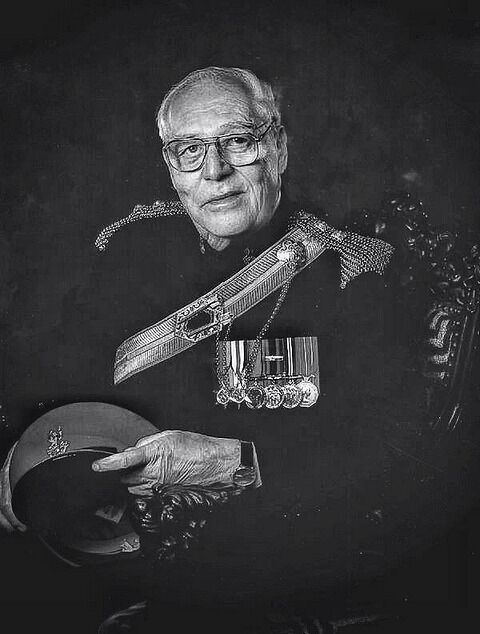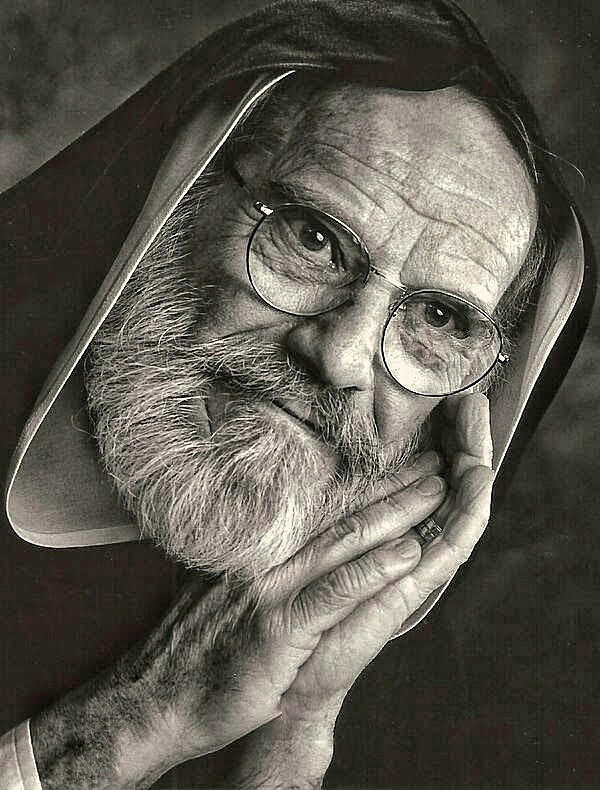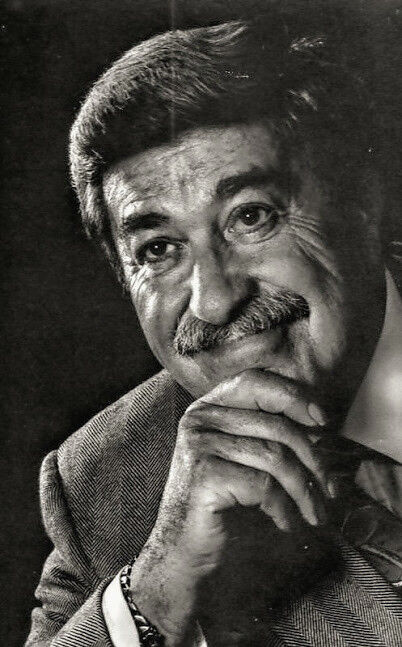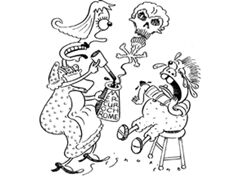Monochrome conversion: portraits
Mar 11, 2023 11:06:30 #
Tote1940
Loc: Dallas
Dear Hoggs:
Idle thoughts on best channel to use to do monochrome conversions of portraits.
Reason for this : idle thoughts about gorgeous Portraits late 19th early 20th Centuries.
Granted, these are all contact prints from very large format negatives, lit by masters mostly in Studio
Google Nadar, his are amazing; he built an special studio on top floor of building with large skylights that could be controlled by draperies and diffusers.
Their films were awfully slow and all orthochromatic.
For young ones, these plates and films were not sensible to red spectrum. Panchromatic films I think did not appear until later.
Skin tones and gray scale were amazing. Now they knew how to expose and develop to achieve gray scale they wanted (was Weston who described zone system? did he use Orthochromatic?) but their long gray scale so well utilized are simply amazing.
Look at old prints and examine skin tones, how they modeled with light and used full scale.
Now in digital photography we could achieve orthochromatic sensitivity by using a filter or choosing appropriate channel to do monochrome conversion.
Has anyone tried this on portraits? Do skin tones vary?
Plan to play with this in future.
Let's keep shooting and playing with our little creative toys
El Tote in Dallas
Idle thoughts on best channel to use to do monochrome conversions of portraits.
Reason for this : idle thoughts about gorgeous Portraits late 19th early 20th Centuries.
Granted, these are all contact prints from very large format negatives, lit by masters mostly in Studio
Google Nadar, his are amazing; he built an special studio on top floor of building with large skylights that could be controlled by draperies and diffusers.
Their films were awfully slow and all orthochromatic.
For young ones, these plates and films were not sensible to red spectrum. Panchromatic films I think did not appear until later.
Skin tones and gray scale were amazing. Now they knew how to expose and develop to achieve gray scale they wanted (was Weston who described zone system? did he use Orthochromatic?) but their long gray scale so well utilized are simply amazing.
Look at old prints and examine skin tones, how they modeled with light and used full scale.
Now in digital photography we could achieve orthochromatic sensitivity by using a filter or choosing appropriate channel to do monochrome conversion.
Has anyone tried this on portraits? Do skin tones vary?
Plan to play with this in future.
Let's keep shooting and playing with our little creative toys
El Tote in Dallas
Mar 11, 2023 11:25:05 #
Tote1940 wrote:
Dear Hoggs: br Idle thoughts on best channel to us... (show quote)
The other thing they did was makeup.. They used blacks and browns for makeup rather than pinks, reds and tans of todays colors. They knew how these dark colors worked with their orthochromatic films. If you are shooting B&W then your makeup also needs to be B&W.....
Mar 11, 2023 12:57:05 #
fetzler
Loc: North West PA
You can simulate orthochromatic film or blue sensitive film in post processing. In your post processing software (i use Paintshop pro) select the channel mixer reduce the red channel to a small percentage (e.g. 0 -10%) for blue sensitive film reduce the red channel to 0% and the green channel to 0-30%. In the process of copying old photograph that are faded to yellow, I use the blue channel to bring back detail. A 47B filter will also just pass blue light.
Incidentally I recall Ortho film being used for portraits of Men in the 1950s and 1960s
Old photo studios often had soft lighting provided by north facing large windows. Today large light panels or large umbrellas can provide such lighting.
In early mechanical television (pre 1940) the cameras were highly infrared sensitive and special blue and green makeup was used. Our digital sensors are also sensitive to IR but there are filters in place to control this.
Here are a couple of references to make up used in moving making.
http://www.isabelsbeautyblog.com/2015/03/the-history-of-1920s-makeup-in-film/?print=print
https://www.youtube.com/watch?v=yeEjWDBu8Vs
Incidentally I recall Ortho film being used for portraits of Men in the 1950s and 1960s
Old photo studios often had soft lighting provided by north facing large windows. Today large light panels or large umbrellas can provide such lighting.
In early mechanical television (pre 1940) the cameras were highly infrared sensitive and special blue and green makeup was used. Our digital sensors are also sensitive to IR but there are filters in place to control this.
Here are a couple of references to make up used in moving making.
http://www.isabelsbeautyblog.com/2015/03/the-history-of-1920s-makeup-in-film/?print=print
https://www.youtube.com/watch?v=yeEjWDBu8Vs
Mar 11, 2023 17:43:22 #
Mar 11, 2023 18:49:46 #
Tote1940 wrote:
Dear Hoggs: br Idle thoughts on best channel to us... (show quote)
Ortho is typically developed by visual inspection using fair bright red light.
Mar 11, 2023 21:34:43 #
I used Modern (at the time) orthochromatic film for many years, many for masculine and theatrical portraiture. My favorite material was Tri-X Ortho (4163) which was only available in sheet film. It had an (ASA) index of 320 for daylight or electronic flash and 200 firs tungsten. The lower (tungsten) speed was due to its lack of sensitivity in the red partof the spectrum.
Processed by Pyro developers, it was especially suitable for character studies and rendered skin tomes in a very distinctive and dramatic way. The pyro developer, a stringing formula, enabled rich shadow detail in low-key portraits with high lighting ratios.
For a short time, in the 1980s, a few film manufacturers produced orthochromatic emulsion in roll film formats. I seem to recall Agfa. Both Kodak and Agfa suddenly disappeared, perhaps because of poor sales.
So, to kind of simulat the effect I found shooting on panchromatic films such as Verichrom Pan or Trix, and using a GREEN (Wratten XI) filter I was able to come close to the original effect. Verichrom Pan had superior graduation and grain structure, but it was soon discontinued as well.
If I want to simulate that ORTHO effect digitally, I simply shoot in MONOCHROMATIC mode using the same old green filter. There is likely a method of simulating this effect in post-processing bi ut I lie dog it in the camera. In mono mode, I can see the results, as to orthochromatic rendition, right in my viewfinder and make any small adjustment in contrast in post. The filter usage does not adversely affect IQ. I use high-quality Zeiss glass and male 16z20, t0 30x40 portrait images for these files with no loss of quality.
Image tones such as cold, neutral, warm, and sepia can be simulated in printings. I can kinda mimic Kodabromide, Medalist, Opal, or Ektalure in printing by adjusting the red/yellow channels.
Processed by Pyro developers, it was especially suitable for character studies and rendered skin tomes in a very distinctive and dramatic way. The pyro developer, a stringing formula, enabled rich shadow detail in low-key portraits with high lighting ratios.
For a short time, in the 1980s, a few film manufacturers produced orthochromatic emulsion in roll film formats. I seem to recall Agfa. Both Kodak and Agfa suddenly disappeared, perhaps because of poor sales.
So, to kind of simulat the effect I found shooting on panchromatic films such as Verichrom Pan or Trix, and using a GREEN (Wratten XI) filter I was able to come close to the original effect. Verichrom Pan had superior graduation and grain structure, but it was soon discontinued as well.
If I want to simulate that ORTHO effect digitally, I simply shoot in MONOCHROMATIC mode using the same old green filter. There is likely a method of simulating this effect in post-processing bi ut I lie dog it in the camera. In mono mode, I can see the results, as to orthochromatic rendition, right in my viewfinder and make any small adjustment in contrast in post. The filter usage does not adversely affect IQ. I use high-quality Zeiss glass and male 16z20, t0 30x40 portrait images for these files with no loss of quality.
Image tones such as cold, neutral, warm, and sepia can be simulated in printings. I can kinda mimic Kodabromide, Medalist, Opal, or Ektalure in printing by adjusting the red/yellow channels.



Mar 12, 2023 11:51:40 #
fetzler
Loc: North West PA
E.L.. Shapiro wrote:
I used Modern (at the time) orthochromatic film fo... (show quote)
Your portraits are exceptional.
A better filter to use than a green filter would be a cyan filter however such filters are not available except for gels to cover lights. For practical the green filter was a good choice
My Olympus cameras can, however, simulate, a cyan filter (or any other color [RGB or CMY]) in monochrome mode thus allowing one to see the result in the view finder. I have only made such adjustments in post so now I will have to try in camera. Post is easy using OM software. Perhaps, other mirrorless cameras would allow this too.
Mar 12, 2023 13:16:40 #
I have a Cyan camera filter. I used it with panchromatic film and digital cameras when orthochromatic films are rare or discontinued. The cyan filter, made by Tiffen, worked well on landscape and architectural subjects, however, its red filtration was a bit too strong, in my opinion, for portraiture in that it rendered lips as BLACK and oftentimes light brown eyes as too light gray- nearly white.
The filter I have is the only one large enough to fit my rather large 300mm Taylor, Hobson & Cooke variable soft-focus portrait lens that was in use at the time on my large format equipment. The 127mm CC05C was the only one available at the time. I purchased a 77mm 82C for my medium format film cameras. Perhas the 82C was too strong? So, I standardized the XI Green as a nice compromise between orthochromatic and panchromatic renditions.
If you have the filtration built into your camera's monochromatic mode- that is great. Presently, my system doe not has that feature.
As for GEL filters. There WERE optical quality gels that were made by Kodak and designed to use on the lens in the light path. They came in every color and strength for color correction and conversion. They go back to the days when many "professional" color transparency films came with a recommendation for a basic starting filter pack to accommodate variations from one emulsion batch to another. They were held in place by sprig-loaded adapters. These were rather fragile, kind of disposable and that is why I went to glass for portraiture. These gels are no longer manufactured but may be obtained on the used market. The Tiffen Cyan model is now outrageously expensive ($814.00 USD on special order)!
The filter I have is the only one large enough to fit my rather large 300mm Taylor, Hobson & Cooke variable soft-focus portrait lens that was in use at the time on my large format equipment. The 127mm CC05C was the only one available at the time. I purchased a 77mm 82C for my medium format film cameras. Perhas the 82C was too strong? So, I standardized the XI Green as a nice compromise between orthochromatic and panchromatic renditions.
If you have the filtration built into your camera's monochromatic mode- that is great. Presently, my system doe not has that feature.
As for GEL filters. There WERE optical quality gels that were made by Kodak and designed to use on the lens in the light path. They came in every color and strength for color correction and conversion. They go back to the days when many "professional" color transparency films came with a recommendation for a basic starting filter pack to accommodate variations from one emulsion batch to another. They were held in place by sprig-loaded adapters. These were rather fragile, kind of disposable and that is why I went to glass for portraiture. These gels are no longer manufactured but may be obtained on the used market. The Tiffen Cyan model is now outrageously expensive ($814.00 USD on special order)!
Mar 12, 2023 14:26:01 #
Mar 12, 2023 16:18:01 #
Mar 12, 2023 18:01:09 #
peekaboo wrote:
Why is the oiled-down image slightly red ?
I don't know what you mean by "oiled down".
There were many "old" processes from tintypes, to wet plates, to relatively modern print methods using chloride-based papers or chloro-bromide papers. Someoftheses processes had an instance war imag tone and others were brown or sepia toned to produce a warmer skin tone-like feeling to portraits. Some older prints owe their longevity to saline toning which is also part of archival print processing.
There wew also "red proofs" which were contact prints made on a special printing-out paper that utilized ultra-violet ligh and had no chemical process. There were inted for fast proofing and were supposed to fade in time when exposed to light, especially sunlight or any sou containing UV. Portrat photographers did not want clients to "copy" their proofs. Morraculasly, some of those proofs survided in dark closets and drawers and are still somewhat discernable. They are a kind of maroon/red.
Someolder were colored or tinted with transparent OIL paints. Expert colorists had the look of natural color prints or realistic oil paintings. Not expire colorists would dab in rosy cheeks on monochromatic prints- not too good! I had an old great aunt who did that with Q-Tips and Merchrochone - a mercury-based antiseptic that was finally nixed by the FDA as ineffective and unsafe. It didn't do the pictures much good either.
Other reasons for redness are fadeing, oxidation, residual chemicals in the paper not being properly washed, poor storage condition, burnishing, etc.
Attachment: A childhood memeory- I was traumatized by Merchrochrome and became a photographer!

Mar 12, 2023 21:27:13 #
E.L.. Shapiro wrote:
I used Modern (at the time) orthochromatic film fo... (show quote)
Those are wonderful portraits. Pretty much a lost art.
Mar 13, 2023 13:02:08 #
ORpilot wrote:
Those are wonderful portraits. Pretty much a lost art.
Thank you for your kind comments.
Fine classical portraiture is not really a totally lost art. Obviously, it's not the most popular aspect of photography on this forum. There are many reasons why this specialty has lost popularity among many enthusiasts, who excel in other fields but avoid serious portraiture.
Many photographers fully equipped themselves for portrait photography, purchasing the appropriate cameras and lenses, all the lights, backgrounds, and props but fail to accomplish good results many people, clients, subjects, friends, etc.) did not like their portraits. It's a job where y the photograhers not only have to satisfy themselves but the results are at the mercy of their subjects. That's discouraging and if you are a pro, that's bad for business! On this and many other photo forums and social media sites, folks ask "I'm contemplating setting up for headshots (etc). so waht gear should I buy"? kinda thing. The question should be, "waht do I have to know, learn, and master?
Well, it ain't astrophysics or brain surgery, but research, study, education, skill, and practice are required to facilitate one's talent. Excellent "people skills" are prerequisites. Most folks, especially creative ones don't like "RULES" applied to their art. In portraiture, there are, however, many principles. that need to be mastered before creativity can be applied. The rules are the tools- once you are aware of them you can keep them, alter them, or break them. The principles have to do with lighting dynamics, posing and body mechanics, facial and body type anaylisis, and of course, basic correct exposure, ratio (contrast), optics, and composition. A good basic portrait is a distortion-free likeness with personality. Most folks want a more flattering interpretation of themselves.
I love to photograph birds, bees, wildlife, landscapes, flowers, antique cars, pets, architecture, sports, street scenes, and all the rest but PEOPLE are the most interesting and challenging subjects.
If you want to reply, then register here. Registration is free and your account is created instantly, so you can post right away.


